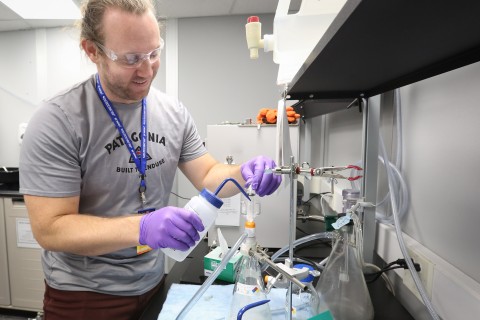University of Notre Dame researchers are using neutrons at the Department of Energy’s (DOE’s) Oak Ridge National Laboratory (ORNL) to study how specialized molecules might improve petroleum production processes, as well as their potential uses in advanced photovoltaic technologies.
“No matter what you want to use petroleum for—whether fuel, feedstock, or making synthetic organic chemicals—you want to use it as efficiently, as cost effectively, and in as an environmentally benign a way as possible,” said Peter Kilpatrick, a professor at Notre Dame.
Specifically, Kilpatrick and PhD candidate McKay Rytting want to know what effects functionalized molecules called petroporphyrins have on asphaltenes—darkly colored, high-molecular-weight molecules abundant in heavy crude oil.
“Asphaltenes cause all kinds of problems in petroleum-related processes. They stick to pipe walls when you pump them; they plug the pipes used in transport; and they produce emulsions,” said Kilpatrick. “Virtually all the challenges associated with petroleum processing come from asphaltenes.”
Similar to how iron binds with hemoglobin—which transports oxygen from our lungs through the bloodstream—petroporphyrins are responsible for binding heavy metals in organic systems to catalyze necessary reactions. Much like asphaltenes, petroporphyrins are also relatively abundant in heavy crude.
“Porphyrins are kind of the key to figuring out how petroleum came from life—from organic lifeforms that died,” said Rytting. “As scientists started finding porphyrin molecules in petroleum, they started connecting them with hemoglobin and chlorophyll, and that’s how we made the connection.”
McKay Rytting, a graduate student at Notre Dame, is preparing petroporphyrin
samples in hydrogenated/deuterated solvent mixtures that will later be
injected into sample cells for analysis. (ORNL/Genevieve Martin)
Porphyrin molecules are brightly colored—some purple, green, blue, and so on—and each variation serves different functions. Their ring-shaped structure allows various atoms to “hang off the edges” of the porphyrin ring that is common to all porphyrins; and those groupings are what determine the molecule’s properties such as overall color, how they absorb light, and how they interact with asphaltenes.
Several years ago, Kilpatrick and his team developed a method of purifying and extracting petroporphyrins from petroleum. They believe the more functionalized petroporphyrins could be used to mitigate many of the problematic behaviors that arise from asphaltene aggregation.
Because neutrons are highly penetrating and sensitive to light elements such as hydrogen, they can be used to track individual atoms and molecular functional groups within dense structures to reveal how they work.
The Extended Q-Range Small-Angle Scattering Diffractometer, or the EQ-SANS instrument, at ORNL’s Spallation Neutron Source—a DOE Office of Science User Facility—allows the team to study a large number of samples to better understand how petroporphyrins and asphaltenes are interacting at the molecular level.
The Notre Dame team is using EQ-SANS, which allows them to study a large
number of different samples in a relatively short period of time. (ORNL/Genevieve Martin)
“The reason neutron scattering is perfect for this research is that we can vary the amount of hydrogen in our solvent by using deuterated or hydrogenated solvents, which tell us how much solvent has been absorbed by the aggregate. We think this will shed light on more efficient processing methods and maybe even new applications in photovoltaics,” said Rytting.
“We think these porphyrins have a lot of other uses that no one has even thought about because they’ve never purified these molecules from petroleum the way we’ve been able to do,” said Kilpatrick. “Neutrons are ideal in helping us realize their potential.”
UT-Battelle manages ORNL for the DOE’s Office of Science. The Office of Science is the single largest supporter of basic research in the physical sciences in the United States and is working to address some of the most pressing challenges of our time. For more information, please visit http://science.energy.gov/.—by Jeremy Rumsey








